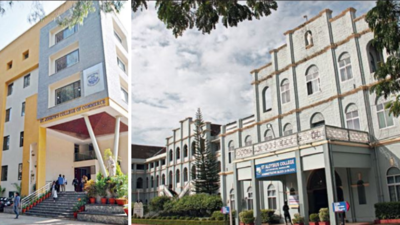Top Searches
- News
- City News
- bengaluru News
- College category: Only two Karnataka institutions in top 100
College category: Only two Karnataka institutions in top 100

While St Joseph’s College of Commerce (L) stands at the 93rd spot, St Aloysius College, Mangaluru is among institutions in the band of 101-150 ranks
BENGALURU: Karnataka’s colleges have not fared well in the National Institutional Ranking Framework (NIRF) 2022 rankings released by the ministry of education even though state higher educational institutions figure in top 100 in good numbers when it comes to other categories.
In the ‘colleges’ category, MS Ramaiah College of Arts, Science, and Commerce has bagged the 55th rank (best in state) and St Joseph’s College of Commerce 93rd.
Karnataka colleges in the band of 101-150 ranks are Kristu Jayanti College, Bengaluru; St Aloysius College, Mangaluru and St Joseph’s Arts & Science College, Lalbagh Road, Bengaluru. Many top colleges from the city have been missing from the NIRF list, year after year. Private colleges say they are at a disadvantage in terms of parameters like student profile, teacher qualifications and filling of seats.
“Colleges with a large number of students from the lower social and economic bracket score better. Therefore, many government colleges get an upper hand. The rankings also look at the number of teachers with PhD and NET. Unlike in a government/aided college, private colleges might not follow this. This affects the student:teacher ratio, and many colleges tend to drop teachers without PhD in the list. Unlike a government college, all seats might not get filled in a private college,” said a professor from a top Bengaluru college.
“It is disappointing, but we do not believe in it much either as these are only statistical measures provided by the college,” she added.
Many educationists question the authenticity of the NIRF rankings. “The data is not validated. It is just self-reported information and there’s merely sample checking of sample institutions. It is a popularity contest of institutions, not a quality contest. If you believe that beauty contests are done to find the best human beings, then go ahead,” said an official working with University Grants Commission. Some say many colleges take the help of agents for data management for rankings.
A faculty member of a Bengaluru institution that improved its score drastically said there were consolidated efforts to up the ranking. “Conscious strategies/policies were developed and investments made. We ensured that admissions were made from various parts of the country to improve regional diversity. The number of scholarships was increased. Extra efforts were made in documentation, data management and presentation of data,” said the faculty member.
A faculty member of another college pointed out that private colleges in Bengaluru do not have as much autonomy as those in Chennai or Delhi. “The government interferes in matters of private colleges. The imposition of the language policy through NEP and admission through UUCMS are examples. If not the government, universities intervene. Take the case of Srishti School of Design and Technology. What academic freedom are we talking about,” he asked.
Those involved in the process say it’s tedious work. “The process is scientific and the parameters used are credible. The challenge for us is that we are a single discipline college. Perception ranking parameter of NIRF is a challenge too as we do not know whom they are surveying,” said Nirmala Joseph, associate professor, St Joseph’s College of Commerce.
“This calls for a lot of clerical work. To be involved in this exercise is not easy for teachers. Under student progression, one needs to track students graduating from colleges. Only full tuition fee waiver scholarships are considered. However, institutions like ours believe in giving partial scholarships to a larger number of students who are in need. We find it very difficult to get details of government scholarships. This data collection is tedious work that many colleges do not want to invest in. But we enjoy doing it,” she added.
“The rankings are for documentation purpose and that’s why many do not take them seriously,” said the principal of a popular college.
In the ‘colleges’ category, MS Ramaiah College of Arts, Science, and Commerce has bagged the 55th rank (best in state) and St Joseph’s College of Commerce 93rd.
Karnataka colleges in the band of 101-150 ranks are Kristu Jayanti College, Bengaluru; St Aloysius College, Mangaluru and St Joseph’s Arts & Science College, Lalbagh Road, Bengaluru. Many top colleges from the city have been missing from the NIRF list, year after year. Private colleges say they are at a disadvantage in terms of parameters like student profile, teacher qualifications and filling of seats.
“Colleges with a large number of students from the lower social and economic bracket score better. Therefore, many government colleges get an upper hand. The rankings also look at the number of teachers with PhD and NET. Unlike in a government/aided college, private colleges might not follow this. This affects the student:teacher ratio, and many colleges tend to drop teachers without PhD in the list. Unlike a government college, all seats might not get filled in a private college,” said a professor from a top Bengaluru college.
“It is disappointing, but we do not believe in it much either as these are only statistical measures provided by the college,” she added.
Many educationists question the authenticity of the NIRF rankings. “The data is not validated. It is just self-reported information and there’s merely sample checking of sample institutions. It is a popularity contest of institutions, not a quality contest. If you believe that beauty contests are done to find the best human beings, then go ahead,” said an official working with University Grants Commission. Some say many colleges take the help of agents for data management for rankings.
A faculty member of a Bengaluru institution that improved its score drastically said there were consolidated efforts to up the ranking. “Conscious strategies/policies were developed and investments made. We ensured that admissions were made from various parts of the country to improve regional diversity. The number of scholarships was increased. Extra efforts were made in documentation, data management and presentation of data,” said the faculty member.
A faculty member of another college pointed out that private colleges in Bengaluru do not have as much autonomy as those in Chennai or Delhi. “The government interferes in matters of private colleges. The imposition of the language policy through NEP and admission through UUCMS are examples. If not the government, universities intervene. Take the case of Srishti School of Design and Technology. What academic freedom are we talking about,” he asked.
Those involved in the process say it’s tedious work. “The process is scientific and the parameters used are credible. The challenge for us is that we are a single discipline college. Perception ranking parameter of NIRF is a challenge too as we do not know whom they are surveying,” said Nirmala Joseph, associate professor, St Joseph’s College of Commerce.
“This calls for a lot of clerical work. To be involved in this exercise is not easy for teachers. Under student progression, one needs to track students graduating from colleges. Only full tuition fee waiver scholarships are considered. However, institutions like ours believe in giving partial scholarships to a larger number of students who are in need. We find it very difficult to get details of government scholarships. This data collection is tedious work that many colleges do not want to invest in. But we enjoy doing it,” she added.
“The rankings are for documentation purpose and that’s why many do not take them seriously,” said the principal of a popular college.
FOLLOW US ON SOCIAL MEDIA
FacebookTwitterInstagramKOO APPYOUTUBE
Start a Conversation
end of article










